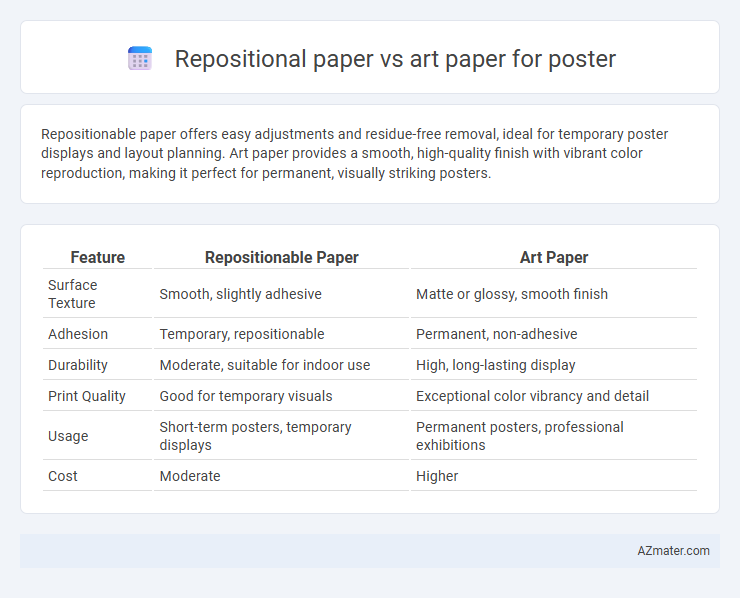Repositionable paper offers easy adjustments and residue-free removal, ideal for temporary poster displays and layout planning. Art paper provides a smooth, high-quality finish with vibrant color reproduction, making it perfect for permanent, visually striking posters.
Table of Comparison
| Feature | Repositionable Paper | Art Paper |
|---|---|---|
| Surface Texture | Smooth, slightly adhesive | Matte or glossy, smooth finish |
| Adhesion | Temporary, repositionable | Permanent, non-adhesive |
| Durability | Moderate, suitable for indoor use | High, long-lasting display |
| Print Quality | Good for temporary visuals | Exceptional color vibrancy and detail |
| Usage | Short-term posters, temporary displays | Permanent posters, professional exhibitions |
| Cost | Moderate | Higher |
Introduction to Poster Printing Materials
Poster printing materials typically include Repositional paper and Art paper, each offering unique benefits for display purposes. Repositional paper features a low-tack adhesive backing that allows easy repositioning without residue, ideal for temporary or changing displays. Art paper provides a smooth, glossy finish with vibrant color reproduction, making it suitable for high-quality, long-lasting posters.
What is Repositional Paper?
Repositional paper is a type of printable material designed for easy removal and repositioning without leaving residue, making it ideal for temporary posters or displays. It features a specially coated adhesive layer that allows users to adjust the placement multiple times, ensuring perfect alignment. Unlike traditional art paper, repositional paper maintains strong print quality while offering flexibility for reuse and repositioning.
What is Art Paper?
Art paper is a high-quality, smooth, and coated paper commonly used for printing vibrant posters, offering excellent color reproduction and sharp detail. It features a glossy or matte finish that enhances the visual appeal of artwork, making images appear more vivid and professional. Compared to repositional paper, art paper is more durable and designed specifically for permanent displays rather than temporary placements.
Key Differences Between Repositional and Art Paper
Repositional paper features a low-tack adhesive backing that allows posters to be easily stuck, removed, and repositioned without damaging surfaces, making it ideal for temporary displays. Art paper offers a smooth, high-quality surface designed to enhance print clarity and color vibrancy, providing a premium finish suitable for permanent displays. The key difference lies in repositional paper's adhesive functionality versus art paper's focus on image quality and durability.
Print Quality: Repositional vs Art Paper
Repositional paper offers moderate print quality with good color accuracy and sharpness, ideal for short-term displays and easy repositioning without residue. Art paper provides superior print quality, featuring vibrant colors, deep contrast, and a smooth matte or glossy finish that enhances the overall appearance of posters for long-lasting, professional presentations. High-resolution images and fine details appear crisper on art paper, making it the preferred choice for premium poster printing.
Durability and Longevity Comparison
Repositional paper offers moderate durability with a semi-permanent adhesive enabling repositioning without damage, making it suitable for short to medium-term posters. Art paper provides superior longevity and durability due to its high-quality fibers and coatings, resisting fading and wear in long-term displays. For posters requiring extended lifespan and robust surface integrity, art paper is the preferred choice over repositional paper.
Application and Usability Scenarios
Repositional paper is ideal for temporary displays, allowing easy removal and repositioning without leaving residue, making it perfect for classroom charts or event signage that requires frequent updates. Art paper offers a higher-quality finish with enhanced color vibrancy and durability, suitable for professional posters, exhibitions, and presentations demanding long-term display and visual impact. Choosing between the two depends on whether the application prioritizes flexibility and reusability or permanence and visual excellence.
Cost Analysis: Which is More Affordable?
Repositional paper typically costs less than art paper due to its simpler manufacturing process and lower material quality, making it an economical choice for temporary or draft posters. Art paper, often made from higher-quality fibers with enhanced finish options like gloss or matte, commands a higher price, reflecting its durability and visual appeal for professional displays. For budget-conscious projects requiring frequent updates or disposability, repositional paper offers significant cost savings compared to the premium investment in art paper.
Environmental Impact and Sustainability
Repositionable paper often contains synthetic adhesives and coatings that can hinder recyclability and increase environmental impact compared to art paper, which is usually made from natural fibers and designed for easier recycling. Art paper, commonly produced with fewer chemical additives and sourced from sustainable forestry practices, supports biodegradability and reduces landfill waste. Choosing art paper for posters promotes eco-friendly printing initiatives by minimizing carbon footprint and supporting circular economy principles.
Choosing the Right Paper for Your Poster Project
Choosing the right paper for your poster project depends on the desired finish and durability; repositionable paper offers flexibility with its adhesive backing, allowing easy repositioning without residue, ideal for temporary displays and interactive presentations. Art paper provides a smooth, high-quality surface that enhances color vibrancy and detail, making it perfect for professional, long-lasting posters with a polished look. Consider the project's purpose and display duration to decide between the functional repositionable option or the aesthetic-driven art paper.

Infographic: Repositional paper vs Art paper for Poster
 azmater.com
azmater.com